Income & Profitability: Mining vs Manufacturing in Australia
VerifiedAdded on 2023/06/13
|11
|2750
|376
Report
AI Summary
This report explores the relationship between income and profitability in the Australian mining and manufacturing sectors, examining data from 2006 to 2015 sourced from the Australian Bureau of Statistics. The study aims to determine if the income and profitability relationship differs between these two sectors, given their differential growth patterns over the past five years. The conceptual framework establishes the fundamental relationship between income, expenses, and profitability, while also assessing the performance of the mining and manufacturing industries in Australia. The literature review explores existing research, highlighting the use of financial ratios like return on sales, assets, and equity in assessing organizational performance. The research plan outlines the data collection process, focusing on income and profit margin figures for various industry groups within the mining and manufacturing sectors. Correlation and regression analyses are proposed to determine the extent to which income and profit variations are related in each sector, providing insights into the factors driving these differences and informing strategies for enhancing productivity and profitability in both industries. Desklib provides a platform for students to access similar solved assignments and past papers.
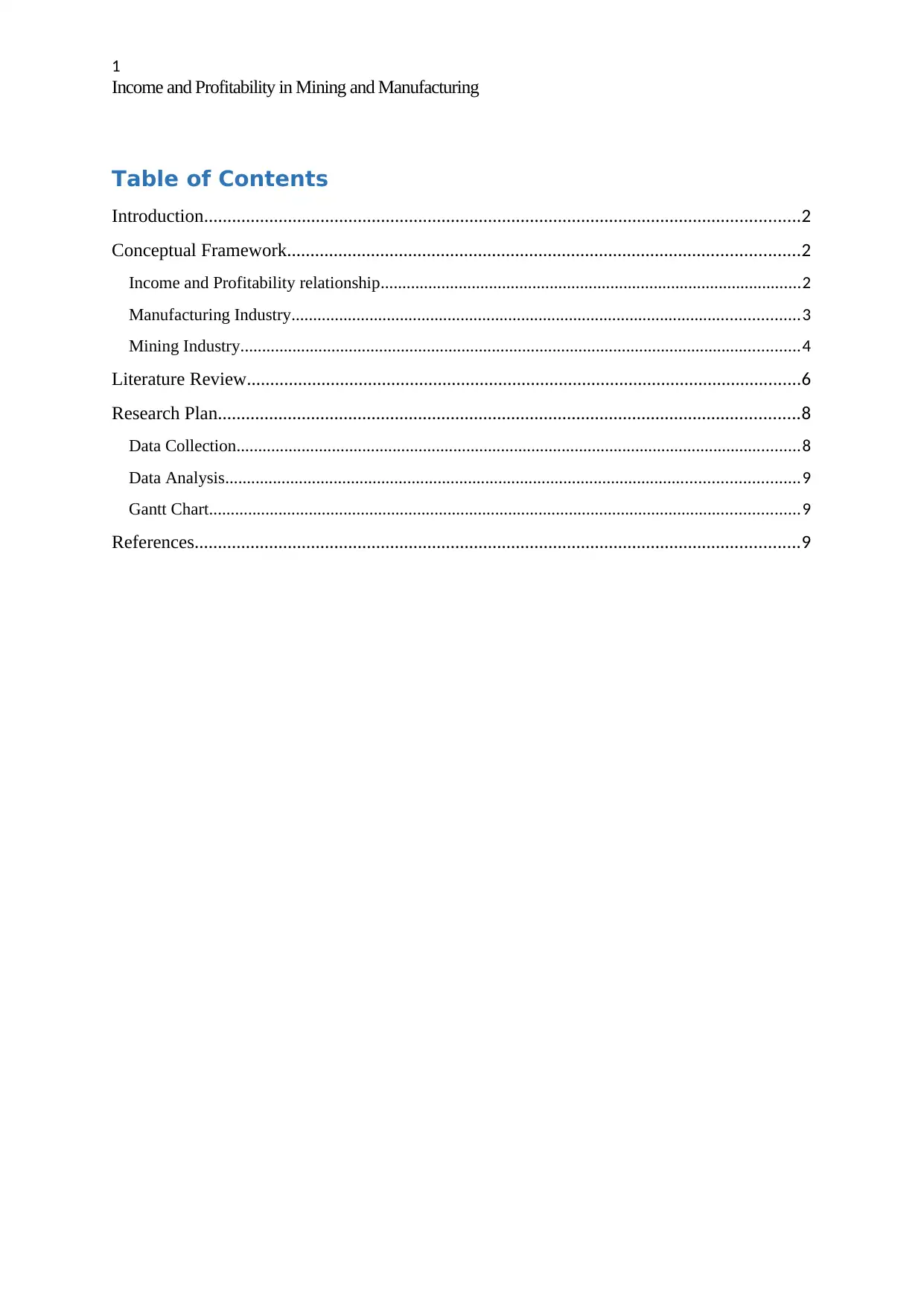
1
Income and Profitability in Mining and Manufacturing
Table of Contents
Introduction................................................................................................................................2
Conceptual Framework..............................................................................................................2
Income and Profitability relationship.................................................................................................2
Manufacturing Industry.....................................................................................................................3
Mining Industry.................................................................................................................................4
Literature Review.......................................................................................................................6
Research Plan.............................................................................................................................8
Data Collection..................................................................................................................................8
Data Analysis....................................................................................................................................9
Gantt Chart........................................................................................................................................9
References..................................................................................................................................9
Income and Profitability in Mining and Manufacturing
Table of Contents
Introduction................................................................................................................................2
Conceptual Framework..............................................................................................................2
Income and Profitability relationship.................................................................................................2
Manufacturing Industry.....................................................................................................................3
Mining Industry.................................................................................................................................4
Literature Review.......................................................................................................................6
Research Plan.............................................................................................................................8
Data Collection..................................................................................................................................8
Data Analysis....................................................................................................................................9
Gantt Chart........................................................................................................................................9
References..................................................................................................................................9
Paraphrase This Document
Need a fresh take? Get an instant paraphrase of this document with our AI Paraphraser
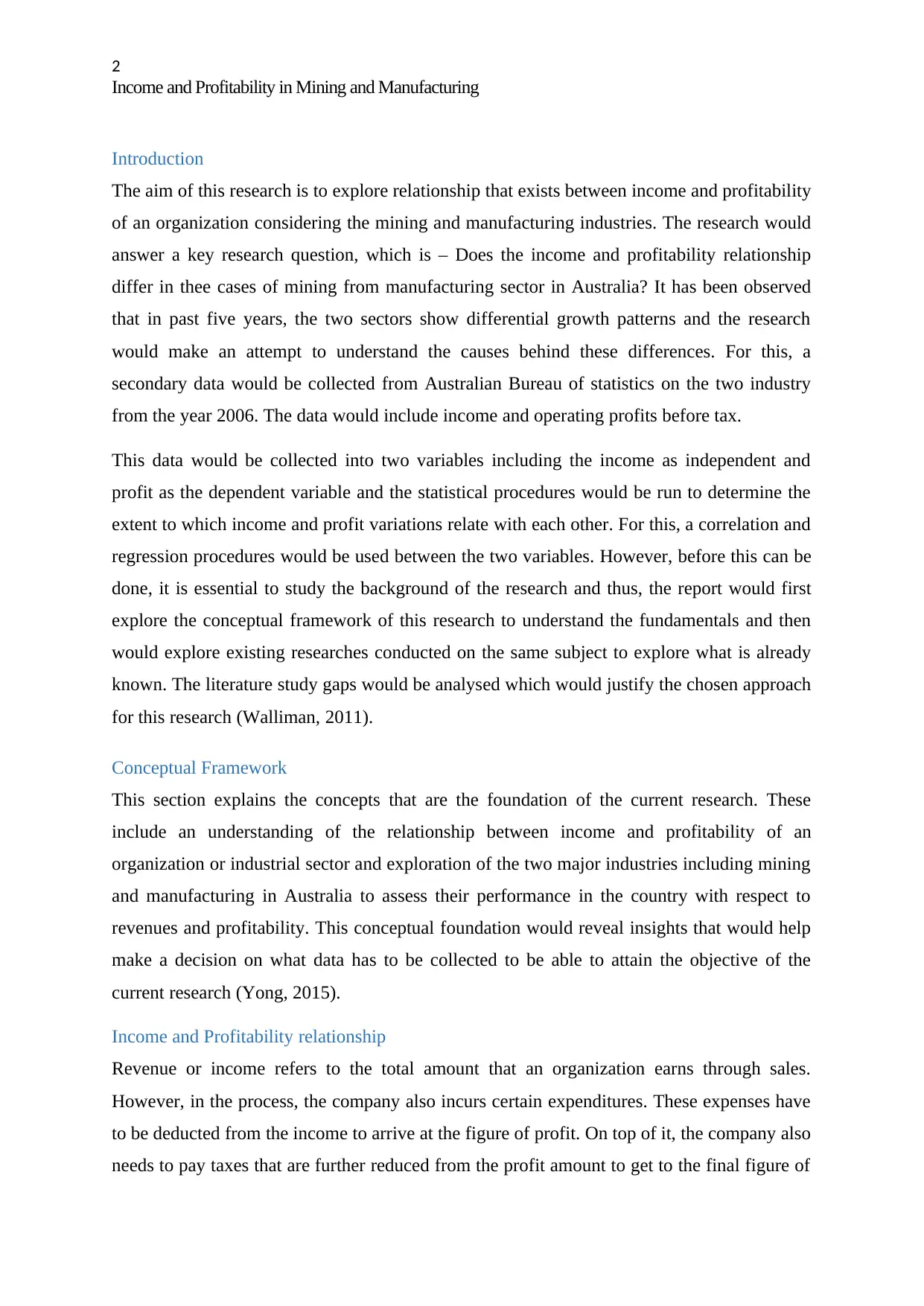
2
Income and Profitability in Mining and Manufacturing
Introduction
The aim of this research is to explore relationship that exists between income and profitability
of an organization considering the mining and manufacturing industries. The research would
answer a key research question, which is – Does the income and profitability relationship
differ in thee cases of mining from manufacturing sector in Australia? It has been observed
that in past five years, the two sectors show differential growth patterns and the research
would make an attempt to understand the causes behind these differences. For this, a
secondary data would be collected from Australian Bureau of statistics on the two industry
from the year 2006. The data would include income and operating profits before tax.
This data would be collected into two variables including the income as independent and
profit as the dependent variable and the statistical procedures would be run to determine the
extent to which income and profit variations relate with each other. For this, a correlation and
regression procedures would be used between the two variables. However, before this can be
done, it is essential to study the background of the research and thus, the report would first
explore the conceptual framework of this research to understand the fundamentals and then
would explore existing researches conducted on the same subject to explore what is already
known. The literature study gaps would be analysed which would justify the chosen approach
for this research (Walliman, 2011).
Conceptual Framework
This section explains the concepts that are the foundation of the current research. These
include an understanding of the relationship between income and profitability of an
organization or industrial sector and exploration of the two major industries including mining
and manufacturing in Australia to assess their performance in the country with respect to
revenues and profitability. This conceptual foundation would reveal insights that would help
make a decision on what data has to be collected to be able to attain the objective of the
current research (Yong, 2015).
Income and Profitability relationship
Revenue or income refers to the total amount that an organization earns through sales.
However, in the process, the company also incurs certain expenditures. These expenses have
to be deducted from the income to arrive at the figure of profit. On top of it, the company also
needs to pay taxes that are further reduced from the profit amount to get to the final figure of
Income and Profitability in Mining and Manufacturing
Introduction
The aim of this research is to explore relationship that exists between income and profitability
of an organization considering the mining and manufacturing industries. The research would
answer a key research question, which is – Does the income and profitability relationship
differ in thee cases of mining from manufacturing sector in Australia? It has been observed
that in past five years, the two sectors show differential growth patterns and the research
would make an attempt to understand the causes behind these differences. For this, a
secondary data would be collected from Australian Bureau of statistics on the two industry
from the year 2006. The data would include income and operating profits before tax.
This data would be collected into two variables including the income as independent and
profit as the dependent variable and the statistical procedures would be run to determine the
extent to which income and profit variations relate with each other. For this, a correlation and
regression procedures would be used between the two variables. However, before this can be
done, it is essential to study the background of the research and thus, the report would first
explore the conceptual framework of this research to understand the fundamentals and then
would explore existing researches conducted on the same subject to explore what is already
known. The literature study gaps would be analysed which would justify the chosen approach
for this research (Walliman, 2011).
Conceptual Framework
This section explains the concepts that are the foundation of the current research. These
include an understanding of the relationship between income and profitability of an
organization or industrial sector and exploration of the two major industries including mining
and manufacturing in Australia to assess their performance in the country with respect to
revenues and profitability. This conceptual foundation would reveal insights that would help
make a decision on what data has to be collected to be able to attain the objective of the
current research (Yong, 2015).
Income and Profitability relationship
Revenue or income refers to the total amount that an organization earns through sales.
However, in the process, the company also incurs certain expenditures. These expenses have
to be deducted from the income to arrive at the figure of profit. On top of it, the company also
needs to pay taxes that are further reduced from the profit amount to get to the final figure of
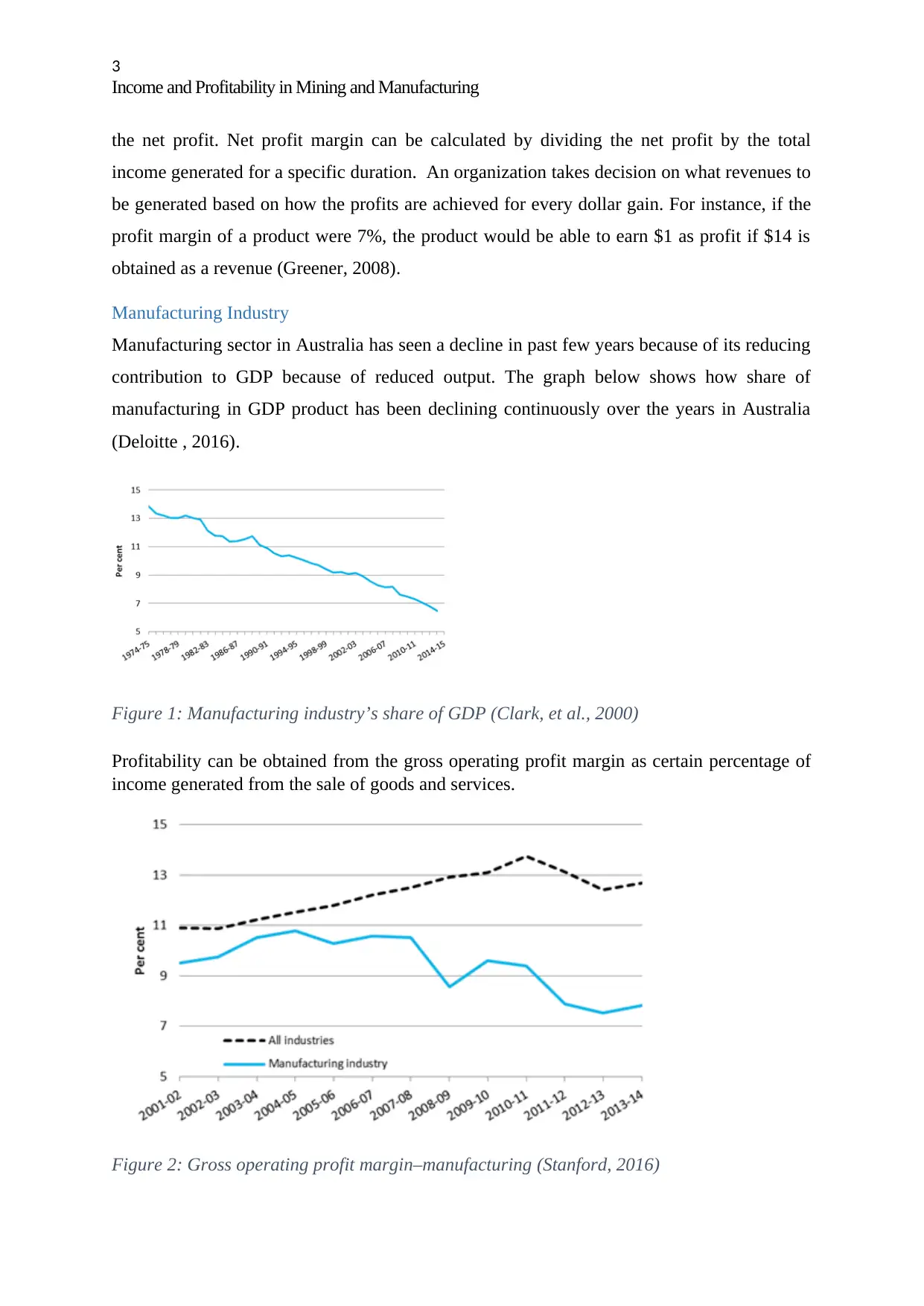
3
Income and Profitability in Mining and Manufacturing
the net profit. Net profit margin can be calculated by dividing the net profit by the total
income generated for a specific duration. An organization takes decision on what revenues to
be generated based on how the profits are achieved for every dollar gain. For instance, if the
profit margin of a product were 7%, the product would be able to earn $1 as profit if $14 is
obtained as a revenue (Greener, 2008).
Manufacturing Industry
Manufacturing sector in Australia has seen a decline in past few years because of its reducing
contribution to GDP because of reduced output. The graph below shows how share of
manufacturing in GDP product has been declining continuously over the years in Australia
(Deloitte , 2016).
Figure 1: Manufacturing industry’s share of GDP (Clark, et al., 2000)
Profitability can be obtained from the gross operating profit margin as certain percentage of
income generated from the sale of goods and services.
Figure 2: Gross operating profit margin–manufacturing (Stanford, 2016)
Income and Profitability in Mining and Manufacturing
the net profit. Net profit margin can be calculated by dividing the net profit by the total
income generated for a specific duration. An organization takes decision on what revenues to
be generated based on how the profits are achieved for every dollar gain. For instance, if the
profit margin of a product were 7%, the product would be able to earn $1 as profit if $14 is
obtained as a revenue (Greener, 2008).
Manufacturing Industry
Manufacturing sector in Australia has seen a decline in past few years because of its reducing
contribution to GDP because of reduced output. The graph below shows how share of
manufacturing in GDP product has been declining continuously over the years in Australia
(Deloitte , 2016).
Figure 1: Manufacturing industry’s share of GDP (Clark, et al., 2000)
Profitability can be obtained from the gross operating profit margin as certain percentage of
income generated from the sale of goods and services.
Figure 2: Gross operating profit margin–manufacturing (Stanford, 2016)
⊘ This is a preview!⊘
Do you want full access?
Subscribe today to unlock all pages.

Trusted by 1+ million students worldwide
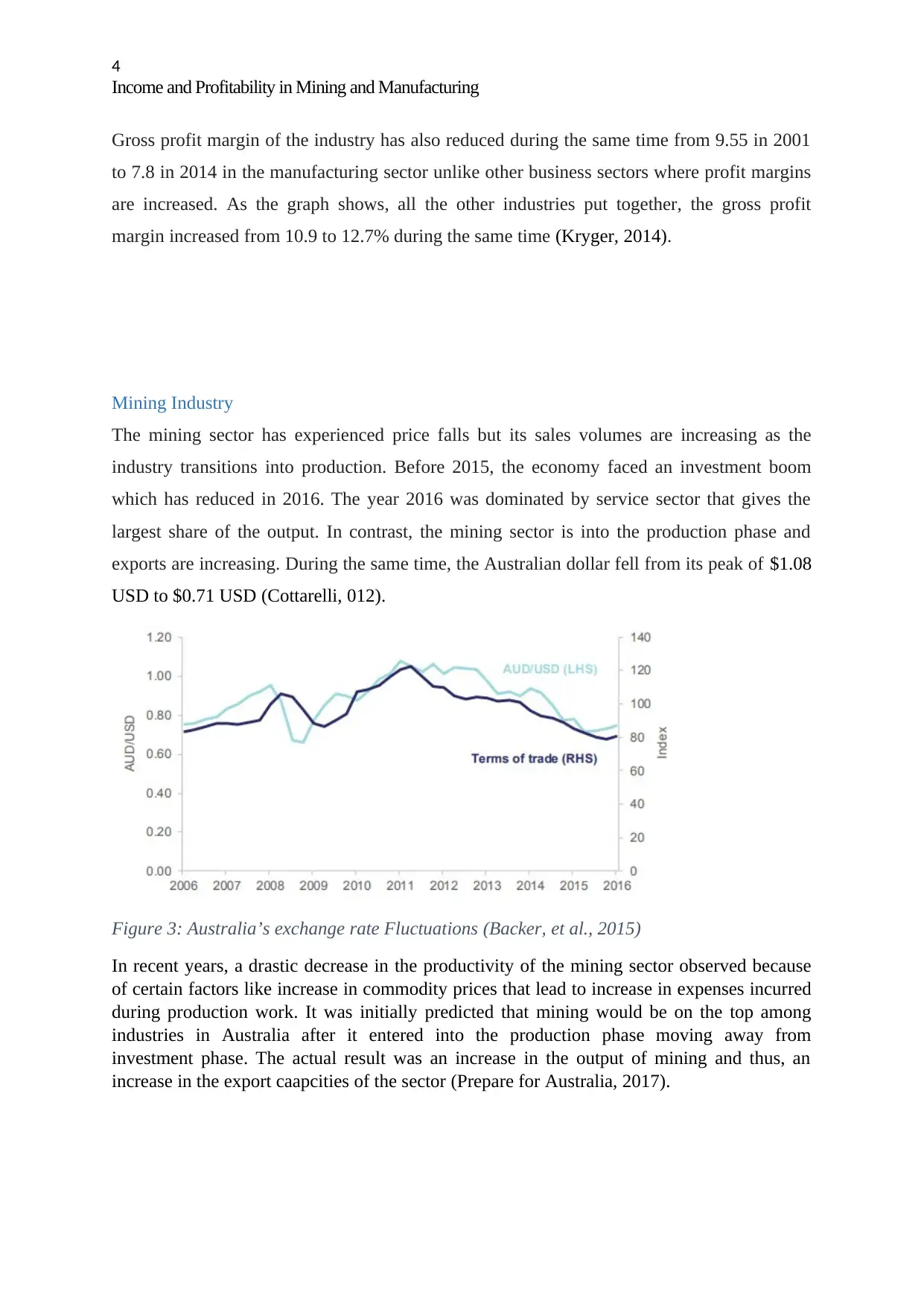
4
Income and Profitability in Mining and Manufacturing
Gross profit margin of the industry has also reduced during the same time from 9.55 in 2001
to 7.8 in 2014 in the manufacturing sector unlike other business sectors where profit margins
are increased. As the graph shows, all the other industries put together, the gross profit
margin increased from 10.9 to 12.7% during the same time (Kryger, 2014).
Mining Industry
The mining sector has experienced price falls but its sales volumes are increasing as the
industry transitions into production. Before 2015, the economy faced an investment boom
which has reduced in 2016. The year 2016 was dominated by service sector that gives the
largest share of the output. In contrast, the mining sector is into the production phase and
exports are increasing. During the same time, the Australian dollar fell from its peak of $1.08
USD to $0.71 USD (Cottarelli, 012).
Figure 3: Australia’s exchange rate Fluctuations (Backer, et al., 2015)
In recent years, a drastic decrease in the productivity of the mining sector observed because
of certain factors like increase in commodity prices that lead to increase in expenses incurred
during production work. It was initially predicted that mining would be on the top among
industries in Australia after it entered into the production phase moving away from
investment phase. The actual result was an increase in the output of mining and thus, an
increase in the export caapcities of the sector (Prepare for Australia, 2017).
Income and Profitability in Mining and Manufacturing
Gross profit margin of the industry has also reduced during the same time from 9.55 in 2001
to 7.8 in 2014 in the manufacturing sector unlike other business sectors where profit margins
are increased. As the graph shows, all the other industries put together, the gross profit
margin increased from 10.9 to 12.7% during the same time (Kryger, 2014).
Mining Industry
The mining sector has experienced price falls but its sales volumes are increasing as the
industry transitions into production. Before 2015, the economy faced an investment boom
which has reduced in 2016. The year 2016 was dominated by service sector that gives the
largest share of the output. In contrast, the mining sector is into the production phase and
exports are increasing. During the same time, the Australian dollar fell from its peak of $1.08
USD to $0.71 USD (Cottarelli, 012).
Figure 3: Australia’s exchange rate Fluctuations (Backer, et al., 2015)
In recent years, a drastic decrease in the productivity of the mining sector observed because
of certain factors like increase in commodity prices that lead to increase in expenses incurred
during production work. It was initially predicted that mining would be on the top among
industries in Australia after it entered into the production phase moving away from
investment phase. The actual result was an increase in the output of mining and thus, an
increase in the export caapcities of the sector (Prepare for Australia, 2017).
Paraphrase This Document
Need a fresh take? Get an instant paraphrase of this document with our AI Paraphraser
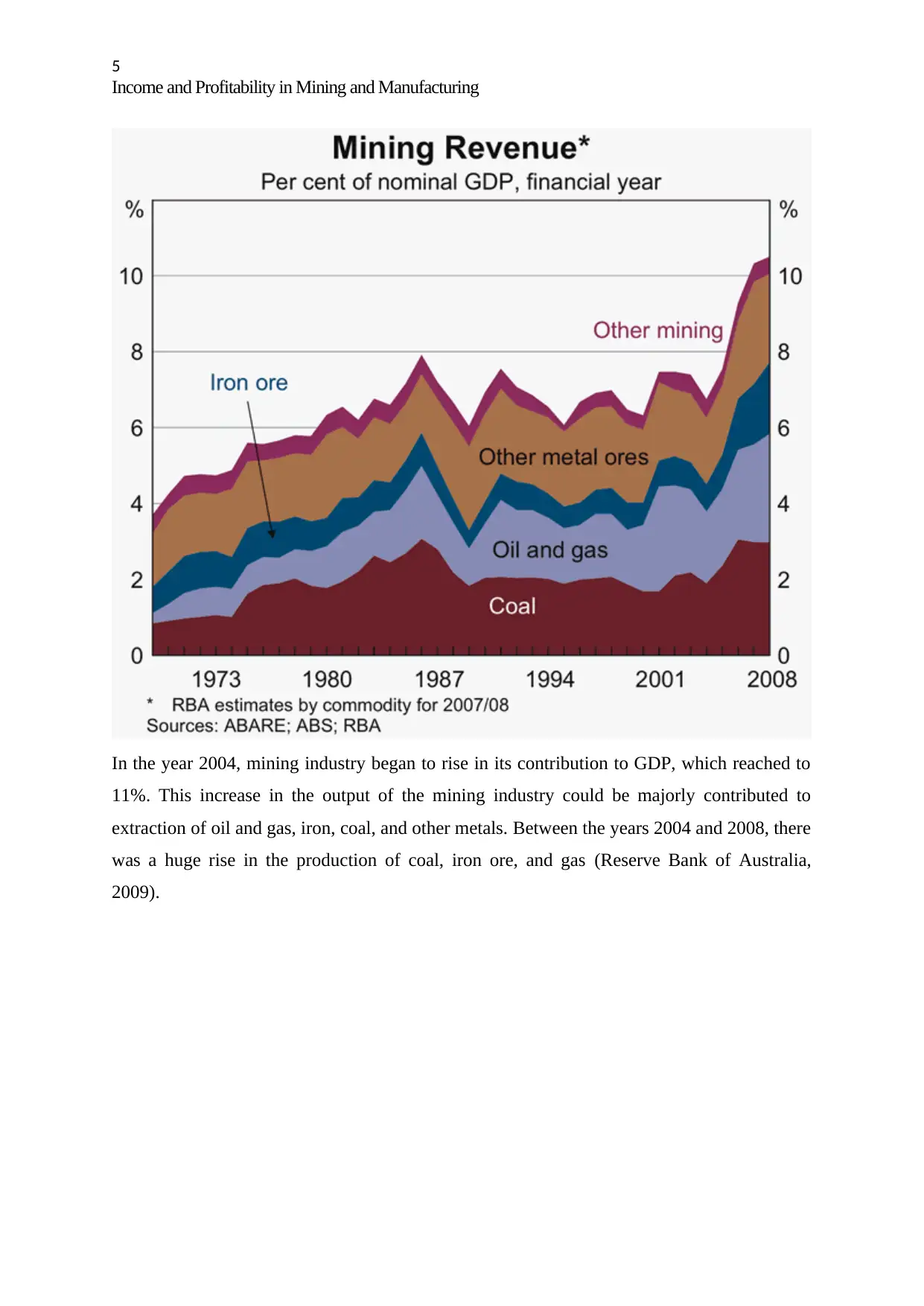
5
Income and Profitability in Mining and Manufacturing
In the year 2004, mining industry began to rise in its contribution to GDP, which reached to
11%. This increase in the output of the mining industry could be majorly contributed to
extraction of oil and gas, iron, coal, and other metals. Between the years 2004 and 2008, there
was a huge rise in the production of coal, iron ore, and gas (Reserve Bank of Australia,
2009).
Income and Profitability in Mining and Manufacturing
In the year 2004, mining industry began to rise in its contribution to GDP, which reached to
11%. This increase in the output of the mining industry could be majorly contributed to
extraction of oil and gas, iron, coal, and other metals. Between the years 2004 and 2008, there
was a huge rise in the production of coal, iron ore, and gas (Reserve Bank of Australia,
2009).
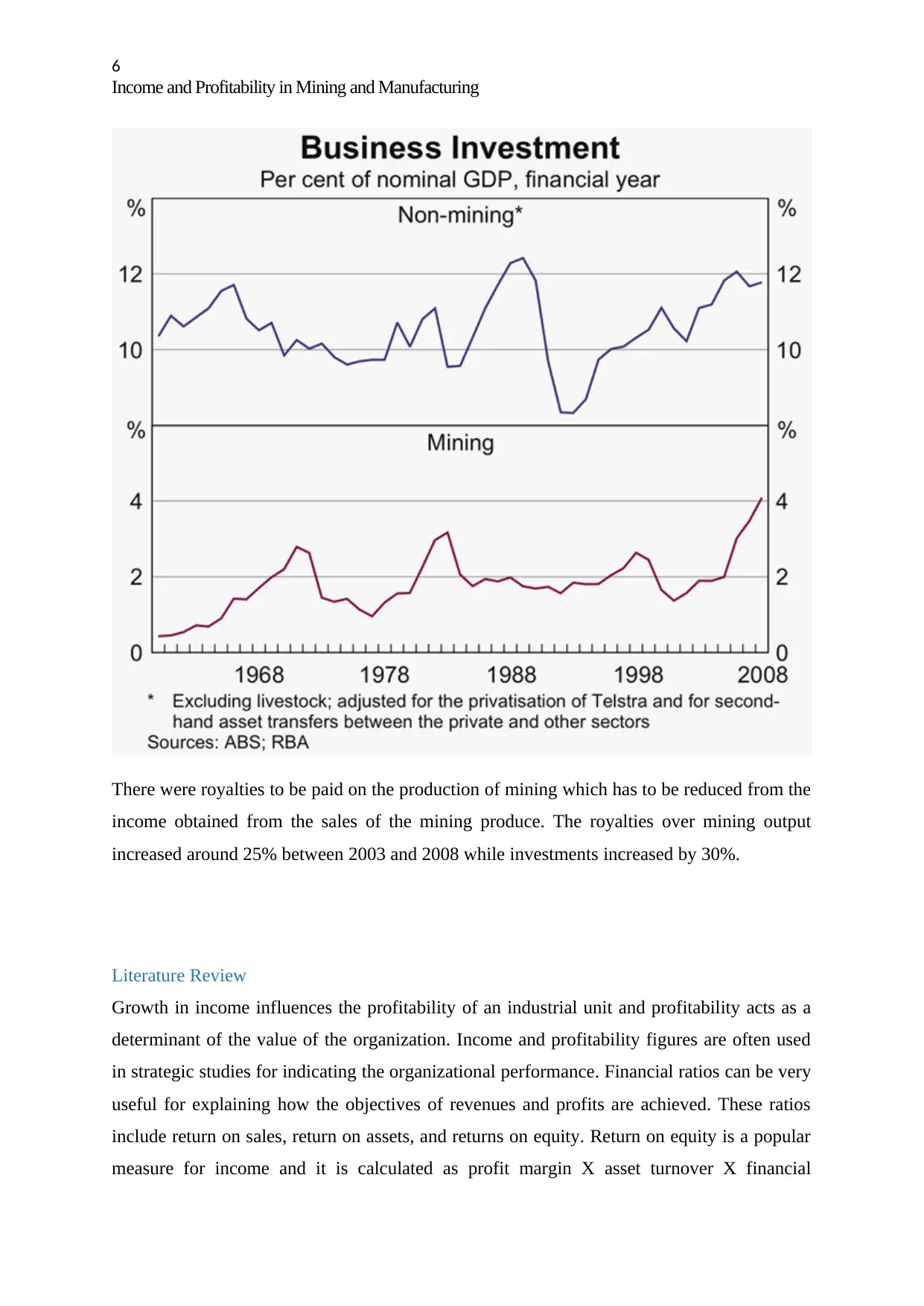
6
Income and Profitability in Mining and Manufacturing
There were royalties to be paid on the production of mining which has to be reduced from the
income obtained from the sales of the mining produce. The royalties over mining output
increased around 25% between 2003 and 2008 while investments increased by 30%.
Literature Review
Growth in income influences the profitability of an industrial unit and profitability acts as a
determinant of the value of the organization. Income and profitability figures are often used
in strategic studies for indicating the organizational performance. Financial ratios can be very
useful for explaining how the objectives of revenues and profits are achieved. These ratios
include return on sales, return on assets, and returns on equity. Return on equity is a popular
measure for income and it is calculated as profit margin X asset turnover X financial
Income and Profitability in Mining and Manufacturing
There were royalties to be paid on the production of mining which has to be reduced from the
income obtained from the sales of the mining produce. The royalties over mining output
increased around 25% between 2003 and 2008 while investments increased by 30%.
Literature Review
Growth in income influences the profitability of an industrial unit and profitability acts as a
determinant of the value of the organization. Income and profitability figures are often used
in strategic studies for indicating the organizational performance. Financial ratios can be very
useful for explaining how the objectives of revenues and profits are achieved. These ratios
include return on sales, return on assets, and returns on equity. Return on equity is a popular
measure for income and it is calculated as profit margin X asset turnover X financial
⊘ This is a preview!⊘
Do you want full access?
Subscribe today to unlock all pages.

Trusted by 1+ million students worldwide
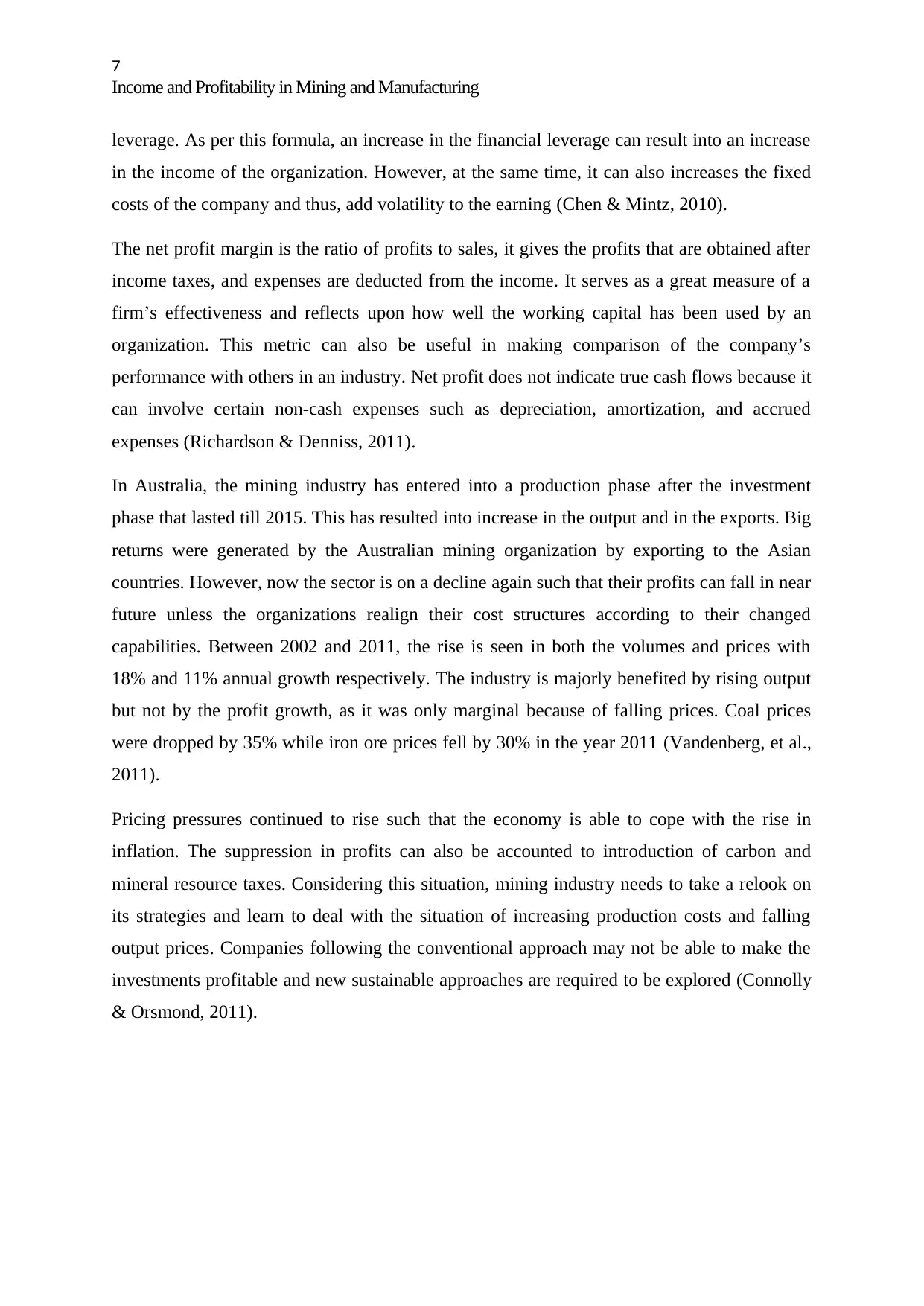
7
Income and Profitability in Mining and Manufacturing
leverage. As per this formula, an increase in the financial leverage can result into an increase
in the income of the organization. However, at the same time, it can also increases the fixed
costs of the company and thus, add volatility to the earning (Chen & Mintz, 2010).
The net profit margin is the ratio of profits to sales, it gives the profits that are obtained after
income taxes, and expenses are deducted from the income. It serves as a great measure of a
firm’s effectiveness and reflects upon how well the working capital has been used by an
organization. This metric can also be useful in making comparison of the company’s
performance with others in an industry. Net profit does not indicate true cash flows because it
can involve certain non-cash expenses such as depreciation, amortization, and accrued
expenses (Richardson & Denniss, 2011).
In Australia, the mining industry has entered into a production phase after the investment
phase that lasted till 2015. This has resulted into increase in the output and in the exports. Big
returns were generated by the Australian mining organization by exporting to the Asian
countries. However, now the sector is on a decline again such that their profits can fall in near
future unless the organizations realign their cost structures according to their changed
capabilities. Between 2002 and 2011, the rise is seen in both the volumes and prices with
18% and 11% annual growth respectively. The industry is majorly benefited by rising output
but not by the profit growth, as it was only marginal because of falling prices. Coal prices
were dropped by 35% while iron ore prices fell by 30% in the year 2011 (Vandenberg, et al.,
2011).
Pricing pressures continued to rise such that the economy is able to cope with the rise in
inflation. The suppression in profits can also be accounted to introduction of carbon and
mineral resource taxes. Considering this situation, mining industry needs to take a relook on
its strategies and learn to deal with the situation of increasing production costs and falling
output prices. Companies following the conventional approach may not be able to make the
investments profitable and new sustainable approaches are required to be explored (Connolly
& Orsmond, 2011).
Income and Profitability in Mining and Manufacturing
leverage. As per this formula, an increase in the financial leverage can result into an increase
in the income of the organization. However, at the same time, it can also increases the fixed
costs of the company and thus, add volatility to the earning (Chen & Mintz, 2010).
The net profit margin is the ratio of profits to sales, it gives the profits that are obtained after
income taxes, and expenses are deducted from the income. It serves as a great measure of a
firm’s effectiveness and reflects upon how well the working capital has been used by an
organization. This metric can also be useful in making comparison of the company’s
performance with others in an industry. Net profit does not indicate true cash flows because it
can involve certain non-cash expenses such as depreciation, amortization, and accrued
expenses (Richardson & Denniss, 2011).
In Australia, the mining industry has entered into a production phase after the investment
phase that lasted till 2015. This has resulted into increase in the output and in the exports. Big
returns were generated by the Australian mining organization by exporting to the Asian
countries. However, now the sector is on a decline again such that their profits can fall in near
future unless the organizations realign their cost structures according to their changed
capabilities. Between 2002 and 2011, the rise is seen in both the volumes and prices with
18% and 11% annual growth respectively. The industry is majorly benefited by rising output
but not by the profit growth, as it was only marginal because of falling prices. Coal prices
were dropped by 35% while iron ore prices fell by 30% in the year 2011 (Vandenberg, et al.,
2011).
Pricing pressures continued to rise such that the economy is able to cope with the rise in
inflation. The suppression in profits can also be accounted to introduction of carbon and
mineral resource taxes. Considering this situation, mining industry needs to take a relook on
its strategies and learn to deal with the situation of increasing production costs and falling
output prices. Companies following the conventional approach may not be able to make the
investments profitable and new sustainable approaches are required to be explored (Connolly
& Orsmond, 2011).
Paraphrase This Document
Need a fresh take? Get an instant paraphrase of this document with our AI Paraphraser
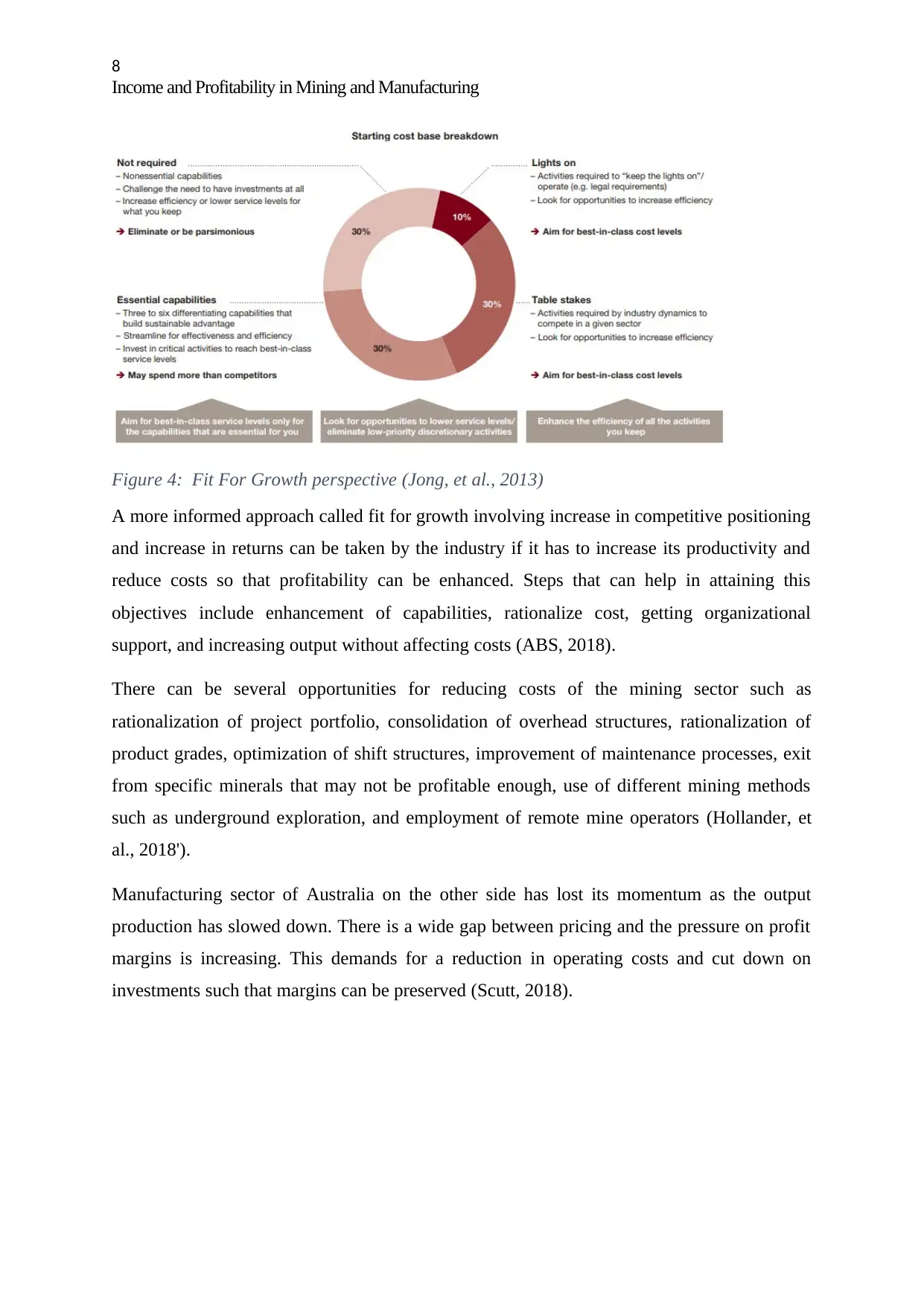
8
Income and Profitability in Mining and Manufacturing
Figure 4: Fit For Growth perspective (Jong, et al., 2013)
A more informed approach called fit for growth involving increase in competitive positioning
and increase in returns can be taken by the industry if it has to increase its productivity and
reduce costs so that profitability can be enhanced. Steps that can help in attaining this
objectives include enhancement of capabilities, rationalize cost, getting organizational
support, and increasing output without affecting costs (ABS, 2018).
There can be several opportunities for reducing costs of the mining sector such as
rationalization of project portfolio, consolidation of overhead structures, rationalization of
product grades, optimization of shift structures, improvement of maintenance processes, exit
from specific minerals that may not be profitable enough, use of different mining methods
such as underground exploration, and employment of remote mine operators (Hollander, et
al., 2018').
Manufacturing sector of Australia on the other side has lost its momentum as the output
production has slowed down. There is a wide gap between pricing and the pressure on profit
margins is increasing. This demands for a reduction in operating costs and cut down on
investments such that margins can be preserved (Scutt, 2018).
Income and Profitability in Mining and Manufacturing
Figure 4: Fit For Growth perspective (Jong, et al., 2013)
A more informed approach called fit for growth involving increase in competitive positioning
and increase in returns can be taken by the industry if it has to increase its productivity and
reduce costs so that profitability can be enhanced. Steps that can help in attaining this
objectives include enhancement of capabilities, rationalize cost, getting organizational
support, and increasing output without affecting costs (ABS, 2018).
There can be several opportunities for reducing costs of the mining sector such as
rationalization of project portfolio, consolidation of overhead structures, rationalization of
product grades, optimization of shift structures, improvement of maintenance processes, exit
from specific minerals that may not be profitable enough, use of different mining methods
such as underground exploration, and employment of remote mine operators (Hollander, et
al., 2018').
Manufacturing sector of Australia on the other side has lost its momentum as the output
production has slowed down. There is a wide gap between pricing and the pressure on profit
margins is increasing. This demands for a reduction in operating costs and cut down on
investments such that margins can be preserved (Scutt, 2018).
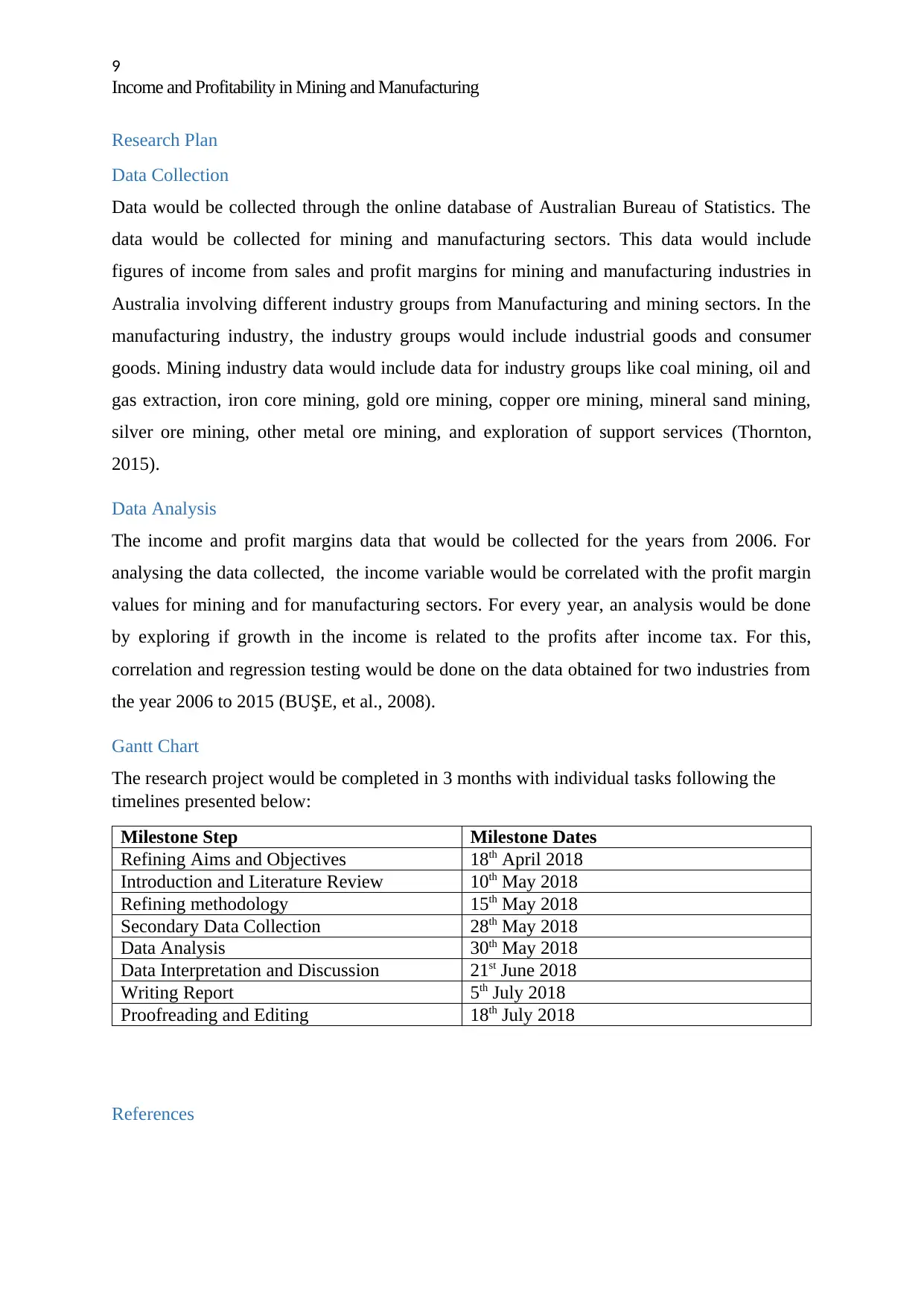
9
Income and Profitability in Mining and Manufacturing
Research Plan
Data Collection
Data would be collected through the online database of Australian Bureau of Statistics. The
data would be collected for mining and manufacturing sectors. This data would include
figures of income from sales and profit margins for mining and manufacturing industries in
Australia involving different industry groups from Manufacturing and mining sectors. In the
manufacturing industry, the industry groups would include industrial goods and consumer
goods. Mining industry data would include data for industry groups like coal mining, oil and
gas extraction, iron core mining, gold ore mining, copper ore mining, mineral sand mining,
silver ore mining, other metal ore mining, and exploration of support services (Thornton,
2015).
Data Analysis
The income and profit margins data that would be collected for the years from 2006. For
analysing the data collected, the income variable would be correlated with the profit margin
values for mining and for manufacturing sectors. For every year, an analysis would be done
by exploring if growth in the income is related to the profits after income tax. For this,
correlation and regression testing would be done on the data obtained for two industries from
the year 2006 to 2015 (BUŞE, et al., 2008).
Gantt Chart
The research project would be completed in 3 months with individual tasks following the
timelines presented below:
Milestone Step Milestone Dates
Refining Aims and Objectives 18th April 2018
Introduction and Literature Review 10th May 2018
Refining methodology 15th May 2018
Secondary Data Collection 28th May 2018
Data Analysis 30th May 2018
Data Interpretation and Discussion 21st June 2018
Writing Report 5th July 2018
Proofreading and Editing 18th July 2018
References
Income and Profitability in Mining and Manufacturing
Research Plan
Data Collection
Data would be collected through the online database of Australian Bureau of Statistics. The
data would be collected for mining and manufacturing sectors. This data would include
figures of income from sales and profit margins for mining and manufacturing industries in
Australia involving different industry groups from Manufacturing and mining sectors. In the
manufacturing industry, the industry groups would include industrial goods and consumer
goods. Mining industry data would include data for industry groups like coal mining, oil and
gas extraction, iron core mining, gold ore mining, copper ore mining, mineral sand mining,
silver ore mining, other metal ore mining, and exploration of support services (Thornton,
2015).
Data Analysis
The income and profit margins data that would be collected for the years from 2006. For
analysing the data collected, the income variable would be correlated with the profit margin
values for mining and for manufacturing sectors. For every year, an analysis would be done
by exploring if growth in the income is related to the profits after income tax. For this,
correlation and regression testing would be done on the data obtained for two industries from
the year 2006 to 2015 (BUŞE, et al., 2008).
Gantt Chart
The research project would be completed in 3 months with individual tasks following the
timelines presented below:
Milestone Step Milestone Dates
Refining Aims and Objectives 18th April 2018
Introduction and Literature Review 10th May 2018
Refining methodology 15th May 2018
Secondary Data Collection 28th May 2018
Data Analysis 30th May 2018
Data Interpretation and Discussion 21st June 2018
Writing Report 5th July 2018
Proofreading and Editing 18th July 2018
References
⊘ This is a preview!⊘
Do you want full access?
Subscribe today to unlock all pages.

Trusted by 1+ million students worldwide
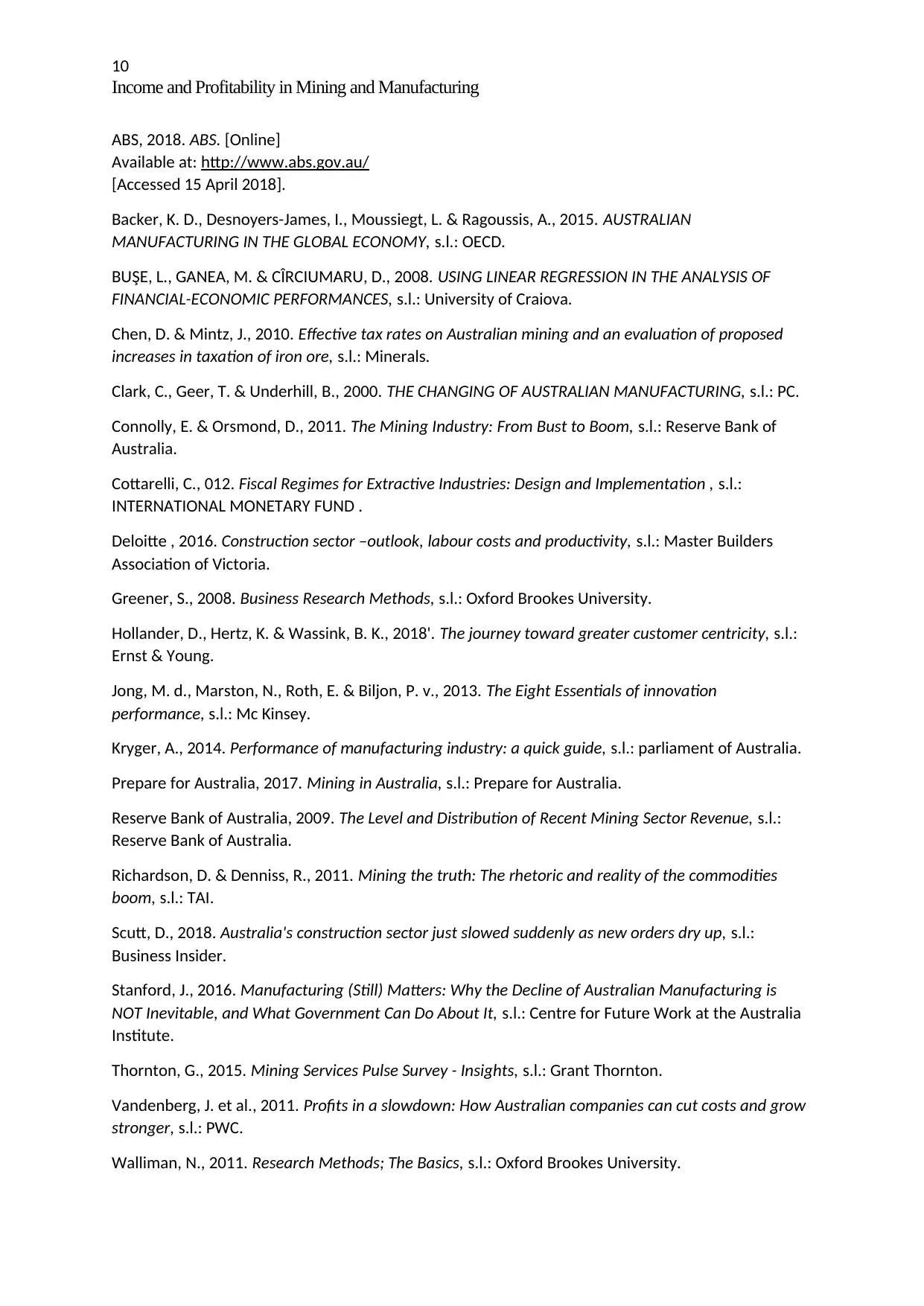
10
Income and Profitability in Mining and Manufacturing
ABS, 2018. ABS. [Online]
Available at: http://www.abs.gov.au/
[Accessed 15 April 2018].
Backer, K. D., Desnoyers-James, I., Moussiegt, L. & Ragoussis, A., 2015. AUSTRALIAN
MANUFACTURING IN THE GLOBAL ECONOMY, s.l.: OECD.
BUŞE, L., GANEA, M. & CÎRCIUMARU, D., 2008. USING LINEAR REGRESSION IN THE ANALYSIS OF
FINANCIAL-ECONOMIC PERFORMANCES, s.l.: University of Craiova.
Chen, D. & Mintz, J., 2010. Effective tax rates on Australian mining and an evaluation of proposed
increases in taxation of iron ore, s.l.: Minerals.
Clark, C., Geer, T. & Underhill, B., 2000. THE CHANGING OF AUSTRALIAN MANUFACTURING, s.l.: PC.
Connolly, E. & Orsmond, D., 2011. The Mining Industry: From Bust to Boom, s.l.: Reserve Bank of
Australia.
Cottarelli, C., 012. Fiscal Regimes for Extractive Industries: Design and Implementation , s.l.:
INTERNATIONAL MONETARY FUND .
Deloitte , 2016. Construction sector –outlook, labour costs and productivity, s.l.: Master Builders
Association of Victoria.
Greener, S., 2008. Business Research Methods, s.l.: Oxford Brookes University.
Hollander, D., Hertz, K. & Wassink, B. K., 2018'. The journey toward greater customer centricity, s.l.:
Ernst & Young.
Jong, M. d., Marston, N., Roth, E. & Biljon, P. v., 2013. The Eight Essentials of innovation
performance, s.l.: Mc Kinsey.
Kryger, A., 2014. Performance of manufacturing industry: a quick guide, s.l.: parliament of Australia.
Prepare for Australia, 2017. Mining in Australia, s.l.: Prepare for Australia.
Reserve Bank of Australia, 2009. The Level and Distribution of Recent Mining Sector Revenue, s.l.:
Reserve Bank of Australia.
Richardson, D. & Denniss, R., 2011. Mining the truth: The rhetoric and reality of the commodities
boom, s.l.: TAI.
Scutt, D., 2018. Australia's construction sector just slowed suddenly as new orders dry up, s.l.:
Business Insider.
Stanford, J., 2016. Manufacturing (Still) Matters: Why the Decline of Australian Manufacturing is
NOT Inevitable, and What Government Can Do About It, s.l.: Centre for Future Work at the Australia
Institute.
Thornton, G., 2015. Mining Services Pulse Survey - Insights, s.l.: Grant Thornton.
Vandenberg, J. et al., 2011. Profits in a slowdown: How Australian companies can cut costs and grow
stronger, s.l.: PWC.
Walliman, N., 2011. Research Methods; The Basics, s.l.: Oxford Brookes University.
Income and Profitability in Mining and Manufacturing
ABS, 2018. ABS. [Online]
Available at: http://www.abs.gov.au/
[Accessed 15 April 2018].
Backer, K. D., Desnoyers-James, I., Moussiegt, L. & Ragoussis, A., 2015. AUSTRALIAN
MANUFACTURING IN THE GLOBAL ECONOMY, s.l.: OECD.
BUŞE, L., GANEA, M. & CÎRCIUMARU, D., 2008. USING LINEAR REGRESSION IN THE ANALYSIS OF
FINANCIAL-ECONOMIC PERFORMANCES, s.l.: University of Craiova.
Chen, D. & Mintz, J., 2010. Effective tax rates on Australian mining and an evaluation of proposed
increases in taxation of iron ore, s.l.: Minerals.
Clark, C., Geer, T. & Underhill, B., 2000. THE CHANGING OF AUSTRALIAN MANUFACTURING, s.l.: PC.
Connolly, E. & Orsmond, D., 2011. The Mining Industry: From Bust to Boom, s.l.: Reserve Bank of
Australia.
Cottarelli, C., 012. Fiscal Regimes for Extractive Industries: Design and Implementation , s.l.:
INTERNATIONAL MONETARY FUND .
Deloitte , 2016. Construction sector –outlook, labour costs and productivity, s.l.: Master Builders
Association of Victoria.
Greener, S., 2008. Business Research Methods, s.l.: Oxford Brookes University.
Hollander, D., Hertz, K. & Wassink, B. K., 2018'. The journey toward greater customer centricity, s.l.:
Ernst & Young.
Jong, M. d., Marston, N., Roth, E. & Biljon, P. v., 2013. The Eight Essentials of innovation
performance, s.l.: Mc Kinsey.
Kryger, A., 2014. Performance of manufacturing industry: a quick guide, s.l.: parliament of Australia.
Prepare for Australia, 2017. Mining in Australia, s.l.: Prepare for Australia.
Reserve Bank of Australia, 2009. The Level and Distribution of Recent Mining Sector Revenue, s.l.:
Reserve Bank of Australia.
Richardson, D. & Denniss, R., 2011. Mining the truth: The rhetoric and reality of the commodities
boom, s.l.: TAI.
Scutt, D., 2018. Australia's construction sector just slowed suddenly as new orders dry up, s.l.:
Business Insider.
Stanford, J., 2016. Manufacturing (Still) Matters: Why the Decline of Australian Manufacturing is
NOT Inevitable, and What Government Can Do About It, s.l.: Centre for Future Work at the Australia
Institute.
Thornton, G., 2015. Mining Services Pulse Survey - Insights, s.l.: Grant Thornton.
Vandenberg, J. et al., 2011. Profits in a slowdown: How Australian companies can cut costs and grow
stronger, s.l.: PWC.
Walliman, N., 2011. Research Methods; The Basics, s.l.: Oxford Brookes University.
Paraphrase This Document
Need a fresh take? Get an instant paraphrase of this document with our AI Paraphraser
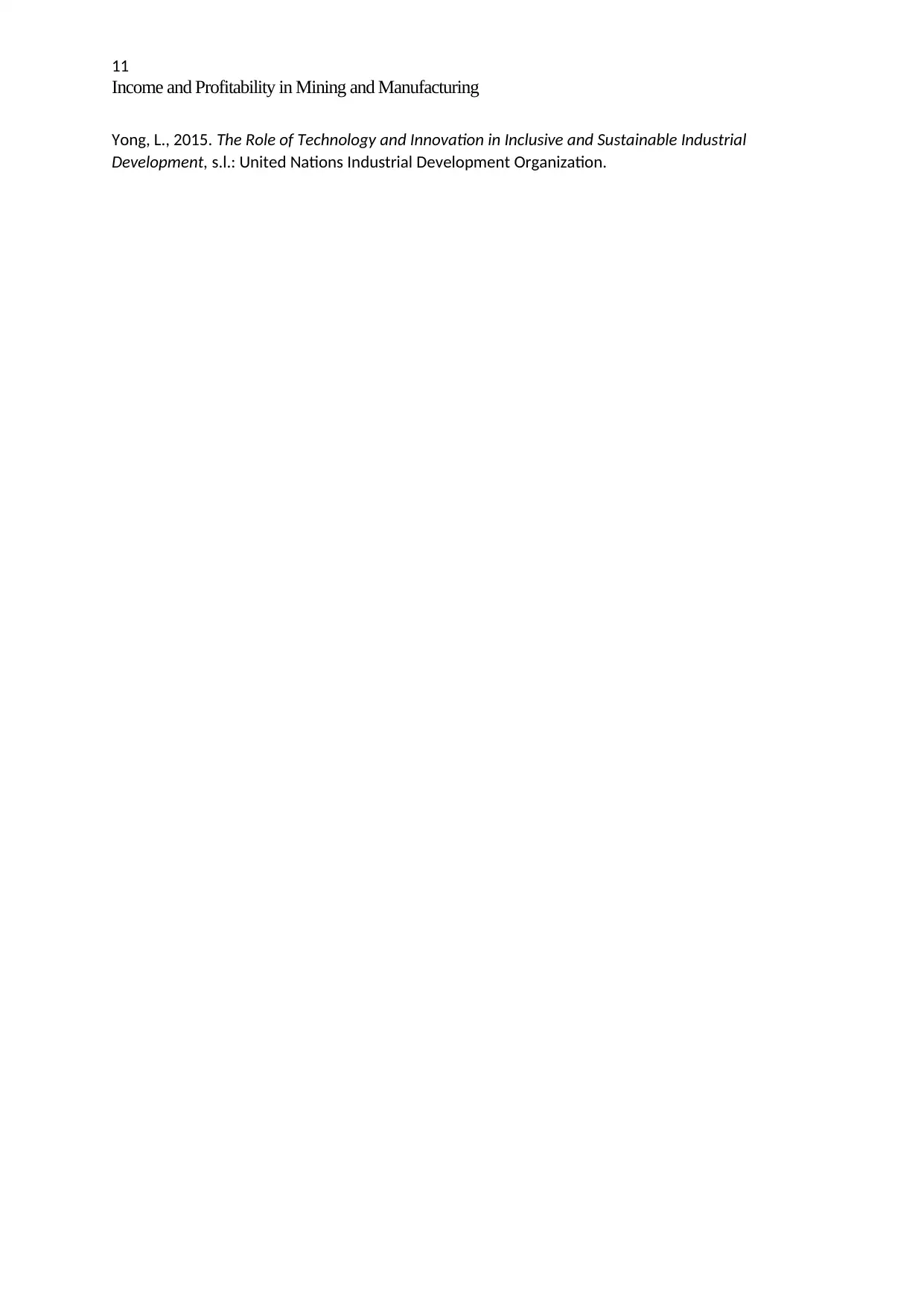
11
Income and Profitability in Mining and Manufacturing
Yong, L., 2015. The Role of Technology and Innovation in Inclusive and Sustainable Industrial
Development, s.l.: United Nations Industrial Development Organization.
Income and Profitability in Mining and Manufacturing
Yong, L., 2015. The Role of Technology and Innovation in Inclusive and Sustainable Industrial
Development, s.l.: United Nations Industrial Development Organization.
1 out of 11
Related Documents
Your All-in-One AI-Powered Toolkit for Academic Success.
+13062052269
info@desklib.com
Available 24*7 on WhatsApp / Email
![[object Object]](/_next/static/media/star-bottom.7253800d.svg)
Unlock your academic potential
Copyright © 2020–2025 A2Z Services. All Rights Reserved. Developed and managed by ZUCOL.





